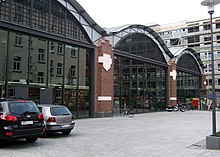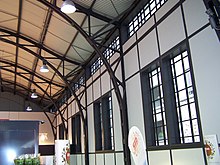Bornheim depot
The Bornheimer Depot (also: Wagenhalle Bornheim , formerly: Depot Bornheim ) was a depot of the Frankfurt tram from 1902 to 2003 . Immediately in front of the depot was the “Heidestrasse” stop , which has now also been closed.
History of the company
The municipal tram in Frankfurt am Main built the depot in the Bornheim district at Heidestrasse 137 to replace a horse-drawn tram depot of the Frankfurt Tramway Company at Berger Strasse 228 that was opened in 1879 and closed in 1900 , as this could not be used for the electric trams . In the residential building belonging to the depot area , the Frankfurt am Main tram set up a station administration on the ground floor. The Bornheim depot was opened to traffic on April 4, 1902 . It comprised thirteen sidings for 100 railcars and sidecars . The tracks two to thirteen were in the halls and the track one outdoors.
The depot was expanded in 1903 and 1907. A fourteenth hall track, where there was space for a car, was laid out, as well as further halls arranged on the side with tracks 15 to 33. The fourteenth track was removed a short time later and tracks 15 to 33 were given the numbers 14 to 32.
During the Second World War , the depot was hit several times by aerial bombs and badly damaged during the air raids on Frankfurt am Main . Members of the Wehrmacht ensured that the depot facilities were restored as soon as possible after the bombing . During the business interruption, a rail replacement service with buses was set up. The custodian halls were until 1952 rebuilt . The property on which the gymnasium of the Bornheim gymnastics community, which was also destroyed during the war, stood in Gronauer Strasse, became part of the depot area.
In tram circles , the Bornheimer depot was also referred to as " Cadol Debbo " (Frankfurt dialect) until the 1950s , as a large part of the members of the Catholic workers' movement in Bornheim were employees of the municipal vehicle fleet or the Bornheim tram depot.
In 1971 the depot was heavily rebuilt . A double-track turning loop was created on the site for the former tram lines 10 to Höchst and 20 to Bergen , as they needed a new turning point due to the construction of the U4 line . The construction of the turning loop required the demolition of the car halls with tracks 21 to 32. Tracks 14 to 19 were then used by the railway construction department and no longer for passenger cars .
From August 1, 1971, the Bornheim depot was only a branch of the Eckenheim depot . Therefore, no more repairs were carried out on the vehicles in Bornheim . These have now been carried out in Eckenheim . The line 18, which started in Bornheim, was developed by staff of the depots Gutleut operated. Finally, the turning loop of the Bornheimer depot also served as the final stop for the Ebbelwei-Express .
Shutdown and present
The anniversary celebration on the occasion of the 25th anniversary of the Ebbelwei-Express took place in 2002 in the Bornheimer Depot. In 2003 the VGF closed the depot at the same time as the Sachsenhausen depot and replaced it with the East Depot . Nevertheless, the first two vehicles of the new S series were presented on October 17, 2003 in Frankfurt-Bornheim . For this purpose, the overhead line that had already been dismantled was restored on a track.
After the presentation of the S-wagon, the systems were finally shut down, the overhead lines were threaded and the switch blades were welded. The ABG Frankfurt Holding built the site with residential buildings in the passive house standard , which were completed in summer 2009.
An underground car park was built under the former depot area . Extensive civil engineering work was necessary for this. A large part of the development on the site was removed in 2006. The dismantled steel girders of the main car hall were transported away for sandblasting and - where necessary - repaired. After the civil engineering work was completed, three ships of the main carriage hall were rebuilt. In them in 2008 is since the end of April a REWE - supermarket .
The house, on which remains one antenna of private mobile radio of the VGF is was, so that only in good condition roof and the individual apartments to be replaced had to. The old toilet house for the drivers and conductors , like the car hangars , was demolished due to the civil engineering work and was rebuilt after its completion. In the meantime there was a branch of the bell bakery .
The nearby turning loop on the test item was shut down in June 2007 and the overhead line was almost completely removed. In 2008, it was still possible to use it as a butt track until the former turning loop was separated from the rail network by expanding the switches . The reason for the abandonment of the turning loop was the construction of a driveway to the underground car park of the Bethanien Hospital on the Prüfling, built in 2009 under the rose garden.
In order to be flexible in the event of operational disruptions or line interruptions due to construction work, a simple track change was installed in Burgstrasse, which makes it possible to use the Burgstrasse stop for line 12 as the final stop. This opportunity was used in summer 2009 as part of the construction work by the city of Frankfurt to redesign Neebplatz. As part of the redesign, the old access tracks to the depot and the turning loop were also removed.
literature
- Dieter Höltge, Günter H. Köhler: Trams and light rail vehicles in Germany . 2nd Edition. 1: Hessen. EK-Verlag , Freiburg 1992, ISBN 3-88255-335-9 .
- Horst Michelke, Claude Jeanmaire: One hundred years of Frankfurt trams: 1872 - 1899 - 1972 = Tramways of Frankfurt am Main (Western Germany) . 1st edition. Villigen AG: Verlag Eisenbahn, book publisher for railway and tramway literature, Brugg / Switzerland 1972, ISBN 3-85649-018-3 .
- Richard Steinmetz, Elisabeth Apweiler, Herbert Apweiler, Hans-Peter Brack, Ernst Koch, Winfried Knies, Gabriele Seybold, Günther Welper: Courage to move on - 125 years of the community of St. Josef Frankfurt am Main - Bornheim . Catholic parish St. Josef , Frankfurt am Main 1994, p. 141-142 .
Individual evidence
- ^ Anton Wiedenbauer, Hans-Jürgen Hoyer: Ride into the future - The history of the Frankfurt tram. P. 126.
- ↑ Horst me Elke, Claude Jeanmaire: One Hundred Years of Frankfurt trams. P. 238.
- ↑ Horst me Elke, Claus Jeanmaire: One Hundred Years of Frankfurt trams. P. 306.
- ↑ Turngemeinde Bornheim 1860 e. V. - We have been moving Frankfurt for 150 years! - From the pub garden to the sports center. - The TG Bornheim from 1860 to 2010. Festschrift for the 150th anniversary of the association, Frankfurt-Bornheim, May 25, 2010
- ↑ Richard Steinmetz, Elisabeth Apweiler, Herbert Apweiler, Hans-Peter Brack, Ernst Koch, Winfried Knies, Heinz Schutt, Gabriele Seybold, Günther Welper: Courage to go on - 125 years of the community of St. Josef Frankfurt am Main - Bornheim. Katholische Pfarrgemeinde St. Josef, Frankfurt 1994, pp. 141–142.
Web links
Coordinates: 50 ° 7 ′ 40 ″ N , 8 ° 42 ′ 29 ″ E









